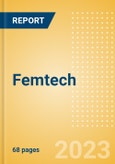Femtech refers to a wide range of technologies and products that aim to address women's health issues, including menstrual health, reproductive health, sexual health, maternal health, and menopause. It includes mobile health (mHealth), telemedicine platforms, wearable devices, diagnostic tools, and even drugs for treating conditions that disproportionately impact women.
COVID-19 accelerated the adoption of digital health and increased demand for apps, telemedicine, digital therapeutics (DTx), and wearables that cater specifically to women's health. These not only allowed women to continue to receive care during lockdown, but also provided new avenues of care to those unable to access traditional services prior to the pandemic for various reasons such as stigma or cultural restrictions. While the Femtech industry is still relatively young, there is a growing awareness and recognition of the need for innovation to improve unmet needs in women's health. The market faces several challenges, such as limited access to funding and a lack of investment from traditional healthcare companies. However, as it continues to mature and more investment and funding is directed towards this area, it is hoped that women will have greater access to care in the future
Scope
The report includes:
- Key players in the Femtech space, with a focus on digital health technologies such as mHealth, telemedicine, DTx, and wearable technology that are used to treat female health conditions, including menstrual health, reproductive health, sexual health, maternal health, and menopause
- Trends: This section looks at key industry, technology, macroeconomic, and regulatory trends impacting the Femtech space
- Industry analysis including a comprehensive deals section. It also includes case studies, primary research, hiring trends, and social media analysis
- Value chain which looks at different segments of the Femtech space, including mHealth, telemedicine, DTx, and wearable technology
- Companies: Examples of companies in Femtech space
Reasons to Buy
- Get an overview of what digital technologies are being used in the Femtech space
- See which technologies are most suitable to different women's health conditions
- Understand which healthtech companies are active in the space, with examples of leaders and challengers by technology
- Understand what opportunities exist for partnerships to drive innovation and provide additional value to patient offerings
- Understand the competitive landscape with a review of strategic partnerships and funding deals in Femtech
- Understand KOL perspectives on Femtech
- Understand industry perspectives on Femtech.
Table of Contents
- Executive Summary
- Players
- Technology Briefing
- Trends
- Healthcare trends
- Technology trends
- Macroeconomic trends
- Regulatory trends
- Industry Analysis
- Deal activity
- Case studies
- Primary research
- Social media trends
- Value Chain
- mHealth apps
- Digital therapeutics
- Wearable technology
- On-demand telemedicine
- Companies
- Appendix
- Abbreviations
- Further reading
- Our thematic research methodology
- About the Publisher
- Contact the Publisher
Table 1: Healthcare trends impacting Femtech
Table 2: Technology trends impacting Femtech
Table 3: Macroeconomic trends impacting Femtec
Table 4: Regulatory trends impacting Femtech
Table 5: Recent strategic partnerships in the Femtech space
Table 6: Recent funding deals in the Femtech space
Table 7: Recent M&A in the Femtech space
Table 8: Examples of public companies in the Femtech space
Table 9: Examples of private companies operating in the Femtech space
List of Figures
Figure 1: Examples of players in the Femtech and where they sit in the value chain
Figure 2: The Clue app
Figure 3: Ovia Health’s apps, Ovia Fertility, Ovia Pregnancy, and Ovia Parenting
Figure 4: The Ava bracelet
Figure 5: Maven Clinic’s telehealth platform
Figure 6: Breakdown of physicians by specialty and geography
Figure 7: Awareness of Femtech among female patients
Figure 8: Proportion of physicians with patients using Femtech
Figure 9: Proportion of patients using Femtech to address health conditions
Figure 10: Physician perspective on conditions most suitable for Femtech adoption
Figure 11: Physician perspective on conditions where Femtech is being used by patients
Figure 12: Proportion of physicians who would recommend the use of Femtech products to their patients
Figure 13: Physician perspective on the main benefits of using Femtech
Figure 14: Physician perspective on the main benefits and barriers of using Femtech
Figure 15: Physician perspective on the change in use of Femtech over the past five years
Figure 16: Physician perspective on the change in Femtech use over the next five years
Figure 17: Number of tweets related to Femtech has increased since 2019
Figure 18: Word cloud with trends related to Femtech from Twitter Influencer discussions
Figure 19: Examples of popular posts related to Femtech by Twitter Influencers
Figure 20: The Femtech value chain
Figure 21: Examples of mHealth apps players in the Femtech space
Figure 22: Examples of DTx players in the Femtech space
Figure 23: Examples of wearable players in the Femtech space
Figure 24: Examples of telemedicine companies in the Femtech space
Companies Mentioned (Partial List)
A selection of companies mentioned in this report includes, but is not limited to:
- Biowink
- Flo Health
- Natural Cycles
- Ovia Health
- Glow
- Peppy Health
- Chorus Health
- Aura Fertilit
- Axena Health
- viO HealthTech
- HelloBetter
- Curio
- Sword Health
- Vira Health
- BehaVR
- Ava Science
- Oura Health
- Bellabeat
- Bloomlife
- Movano Health
- Nurkor
- Maven Clinic
- Nurx
- Allara Health
- Tia
- Elektra Health
- Syrona Health
- Ease Healthcare








